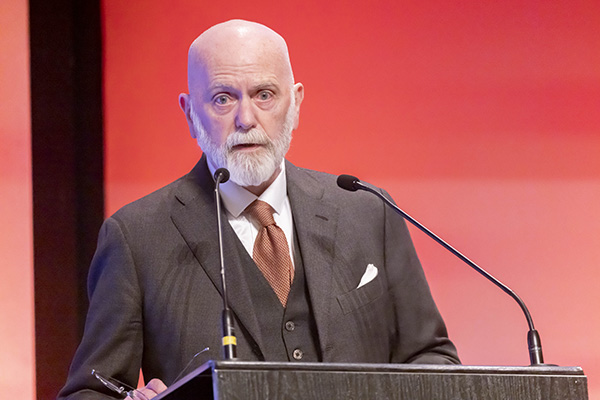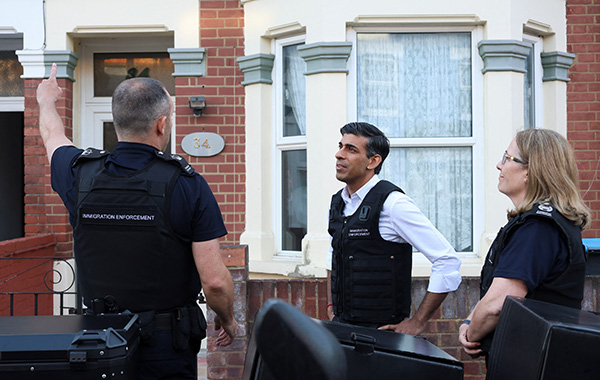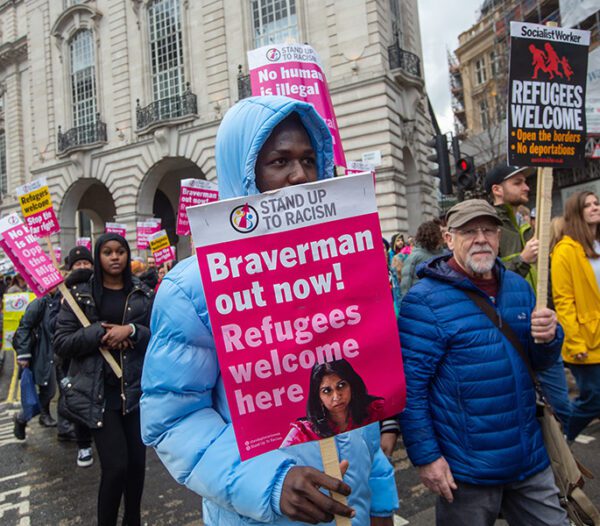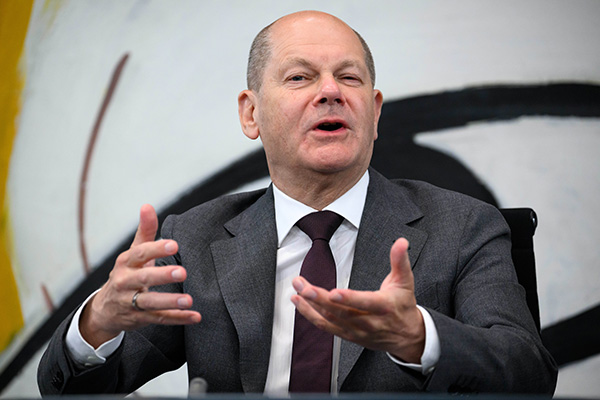The Great Replacement, Western European-Style
Augustin Goland, American Renaissance, June 16, 2023

Credit Image: © Gareth Fuller/PA Wire via ZUMA Press
Subscribe to future audio versions of AmRen articles here.
Even if European nations were to get serious in the fight against illegal immigration, which most of them have yet to do, that would not be enough to stop the Great Replacement. That social-engineering experiment would go on, albeit maybe at a slightly slower pace and with a smaller proportion of criminals and Islamic terrorists making their way to the Old Continent.
Over the years, Western Europe’s mass immigration, which started in earnest in the 1970s, has become self-nurturing and exponential. This is in part because the ruling elite have gotten used to it and are unwilling to close the gates, whatever the consequences, and in part because the right to family reunification of settled immigrants and refugees has become the norm under the auspices of the European Court of Human Rights. Another major factor is that immigrants of African and Middle Eastern origin have more children than people of European descent.
The “Great Replacement” is a term invented by French author Renaud Camus, for whom it has earned the label of far-right conspiracy theorist. Name-calling aside, the term simply describes what is happening now in the western part of the Old Continent, with very low native natality rates on one side and a rapidly increasing population of foreign origin with higher natality rates on the other side.

Renaud Camus (Credit Image: © Vincent Isore/IP3 via ZUMA Press)
Some prefer the term “reversed colonization.” Another Frenchman, Bernard Lugan, a historian and Africanist, wrote a book on that subject, published last year as How France has Become the Colony of its Colonies.
American Renaissance readers might be more focused on the race issue, but a bigger concern for most Western Europeans is the rise of Islam that is linked to this reversed colonization. Also troubling is the simple fact that native Europeans feel less and less at home in their own countries because of the growing presence of foreign cultures, customs, and languages.
A large majority of Europeans want fewer immigrants, but their national governments and representatives to the European Union do not seem to care, even though they might sometimes say otherwise.
An example is the post-Brexit UK, where the Conservative government has presided over an unprecedented rise in legal immigration from outside Europe. In fact, non-Europeans have now more than replaced the citizens of EU countries who left the UK or stopped coming when the Brits left the European Union.
One of the arguments in support of Brexit was that Britain would be able to retake control of its borders, but regaining control of its borders will not stop immigration if its government does not want to.

Pro-Brexit Yellow Vest protestors march on Parliament demanding a no-deal Brexit, an end to immigration, and an end to what they see as mainstream fake news, April 13, 2019. (Credit Image: © Matrix via ZUMA Press)
Net immigration to the UK (the number who came to live in the UK minus the number who left) reached 606,000 for 2022, which is a 24-percent increase over the 488,000 registered the year before and an all-time record.
The non-EU arrivals included: 361,000 students and their families; 235,000 people coming for work-related reasons; 172,000 coming on humanitarian schemes (including 114,000 Ukrainians and 52,000 Hong Kongers); and 76,000 people claiming asylum. Twenty-five percent of the visas issued in 2022 went to Indian nationals, who benefited that year from a 73-percent increase in student visas and a 130-percent hike in work visas.
In 2022, net EU migration was minus 51,000, which means that 51,000 more nationals from EU countries left the UK than came to live there (for at least a year). In addition, in that year, 4,000 British nationals left the UK, while 662,000 non-EU nationals came to stay.
In 2010, when net migration stood at 252,000 people — a large part of which was due to immigration from other EU countries — the Tories promised to bring net immigration down to the “tens of thousands.” Today that promise is largely forgotten.
In 2019, the party promised again, this time to bring net immigration down from the 226,000 prevailing at that time. But then came the huge spike in 2022. By 2023, Prime Minister Rishi Sunak, a practicing Hindu and the son of Punjabi Indians who immigrated from East Africa in the 1960s, has been unwilling to commit to such a reduction, saying only that he wants to “bring the numbers down” somewhat. For that he has been harshly criticized by members of his own party.

Prime Minister Rishi Sunak watches an immigration raid in northwest London, June 15, 2023. (Credit Image: © Susannah Ireland/PA Wire via ZUMA Press)
Work-visa issuance in the UK is based on points, and the new criteria released in 2020, just after Brexit, have contributed to the rise in work-related immigration from outside Europe.
Immigrants on work visas and student visas can also bring dependents (husband, wife, civil or unmarried partner, and any children under 18 years old). Over 135,000 visas were delivered in 2022 for such dependents. Moreover, former students can stay and work in the UK under a graduate visa for two to three years.
“I mean, if net migration over the last few years has been about 300,000 a year, that’s like five parliamentary constituencies of new people every year,” Tory MP Adam Holloway told Nigel Farage on GB News in May 2023. “Over ten years, that’s nearly 50 parliamentary constituencies in terms of people. I know that at least a group of us are asking to see the Home Secretary next week because it’s not just about the Tory Party’s electoral prospects that are shattered by this. But it’s actually about the shape and the feel of our country going forward.”
Home Secretary Suella Braverman is the daughter of Indian parents who immigrated to the UK in the 1960s, from Mauritius and Kenya. Still, she is the one who has been pressing other members of the UK government to revive the 2010 pledge of bringing net migration down to the tens of thousands every year. Meanwhile, her white British colleagues in the cabinet have stubbornly refused to do so, either out of commitments to businesses that want abundant and cheap labor or out of wokeism.

Thousands march for refugees in Central London on UN Anti-Racism Day as UK Home Secretary Suella Braverman visits to Rwanda for talks on UK governments plans to send refugees to African country. (Credit Image: © Tayfun Salci/ZUMA Press Wire)
Ben Harris-Quinney, the chairman of the Bow Group, the oldest conservative think tank in the UK, told Breitbart News in May 2023: “The Conservative Party have broken their now 13-year-old promise to reduce immigration to the tens of thousands because they fear global corporates more than their betrayed voters. Corporates love mass immigration because they want cheap, easy-to-exploit labor, and unnaturally inflated property prices.”
As a consequence of sustained immigration, in large part legal, white Britons made up just under 80 percent of the population in 2019 compared with just under 90 percent in 2001. Worse still, white British births declined from 65 percent of all live births in 2014 to 61 percent in 2019. Between 2011 and 2021, the proportion of England’s and Wales’ residents born outside the UK increased from 13.4 percent of the total population to 16.8 percent. In 2021, almost 29 percent of live births were to women born outside the UK, and the average fertility rate for those women was 2.03 per woman compared with 1.54 for women born in the UK.
In a YouGov poll published in December last year, 57 percent of respondents said the level of immigration into Britain over the previous ten years had been too high, 20 percent said it had been about right, and only 7 percent thought it had been too low. Seventy-two percent said they disapproved of the way the government is currently handling the issue of immigration.
France
In France, too, immigration has been hitting new records. The French president, Emmanuel Macron, is famous for having once said that there is no such thing as French culture, merely cultures in France. And that is indeed the feeling you get when visiting that country, especially but not exclusively its biggest cities, such as Paris.
President Macron is seen by many Frenchmen as a European version of the Canadian PM Justin Trudeau, known for his open-borders policies. Only recently has Mr. Macron been trying to appear willing to limit immigration in the face of growing popular discontent and instability.

Protesters hang a banner from a colonialist statue. Several people mostly the Comorian population, demonstrated in Marseille against the immigration law by the French government of Emmanuel Macron and supported by the Minister of Interior Gérald Darmanin. (Credit Image: © Gerard Bottino/SOPA Images via ZUMA Press Wire)
The facts say otherwise, however, and it is a fact that the government of France, a country of 68 million people, handed out 320,000 first-time residence permits to foreigners in 2022. That was 17 percent more than the year before and almost twice as many as 15 years before. Of those more than 320,000 first-time residence permits, 108,340 were given to students; 90,385 went to family members of legal residents; 52,570 went to economic immigrants; 40,490 were issued on humanitarian grounds; and 28,545 were awarded for other reasons. Additionally, 255,118 visas were delivered for short-term work.
Those numbers will not come down soon if a bill proposed by Macron’s government last year is finally voted into law. That bill would provide, among other things, for the legalization of illegal immigrants working in sectors suffering from a lack of workers, such as the hospitality industry.
In addition, the French government has backtracked on a threat to withhold visas from several African countries that had prevented the return of their citizens deported from France. While on a visit to Algeria in December 2022, French Interior Minister Gérald Darmanin announced “the return of normal consular relations” in regard to the granting of visas. In the case of Algerians alone, that meant that between 300,000 and 400,000 visas would now be issued every year. Worse still, the decision was made despite a lack of progress in encouraging those countries to take back their deported citizens. In 2022, more than 130,000 deportation orders were issued by the French authorities, but fewer than 10 percent were executed. It is a problem that has been ongoing for many years, as many African and Muslim countries in particular have blocked most repatriations of their nationals.

Gérald Darmanin (Credit Image: © Maxppp via ZUMA Press)
Based on official government data from 2021, 7 million immigrants are currently living in France, including 2.5 million who have obtained French citizenship. Of the seven million, 47.5 percent were born in Africa and 13.6 percent in Asia. The most common countries of birth for immigrants are Algeria (12.7 percent), Morocco (12 percent), Portugal (8.6 percent), Tunisia (4.5 percent), Italy (4.1 percent), Turkey (3.6 percent), and Spain (3.5 percent).
But if we take into account the children and grandchildren of immigrants, the number of people of foreign origin in France is 19 million, or 28 percent of the country’s total population. Of the population aged 0–4, the proportion climbs to almost 42 percent. And if we exclude those immigrants of European descent and their offspring, we find that nearly 30 percent of the youngest members of France’s population are not of European origin.
These official figures are based not on ethnicity statistics, which are not allowed in France, but on immigrants’ countries of origin. Sources of other population data include such unofficial figures as the number of tests for sickle cell disease conducted by French hospitals on newborns. Traditionally, those tests have been performed on infants whose parents are of African or Middle Eastern origin. (Those whose parents are from the French Caribbean are also tested, though they could be French citizens and not immigrants.) The data show that 20 percent of newborns in 2001 were tested, while in 2016, almost 40 percent were tested — a near doubling of the percentage. Due to the use of those data by the “far right,” the French government has now ordered hospitals to conduct the tests on all newborns, though the genetic disease does not affect whites.
Apart from the increase in immigration, with legal immigration making up by far the biggest part, the demographic change in France is also caused by differing fertility rates. While the overall fertility rate in France is now around 1.7 children per woman, it is much higher among immigrant women: 3.5 children for women from North Africa, 3.1 for women from Turkey, and 2.9 for women from Sub-Saharan Africa.
More openly than in the UK, the ongoing colonization of France by immigrants coming mostly from its former colonies has raised the alarm about that country being progressively downgraded to the status of third-world. President Macron himself coined the word “decivilization” to describe the evolution of his own country occurring under his mandate. There have also been warnings of a growing risk of civil war by top officials, including President Macron’s predecessor, François Hollande, as well as by Mr. Macron’s first interior minister, Gérard Collomb.
No wonder two-thirds of the French consider the Great Replacement real and not merely a conspiracy theory, and three-quarters think there are too many immigrants in their country.
Speaking of President Macron’s complaints about the “decivilization” of France, his 17th-century countryman Jacques-Bénigne Bossuet, a bishop who was court preacher to King Louis XIV and a renowned orator, had a famous saying for people like him: “God laughs at men who deplore the effects of which they cherish the causes.”
Germany
Germany has also gone pretty far down the road to population replacement, and of late it has been accelerating in that direction. In 2022, out of a total population of about 84 million, 15.3 million people in Germany were foreign born. An additional 4.9 million were the offspring of two immigrants, and another 3.9 million had one immigrant parent.
“That’s a 6.3% rise on the 2021 figure,” noted Deutsche Welle in April. The DW author further wrote: “The high average levels of migration in recent years were also apparent in the statistics. Just over 6 million people had migrated to Germany in the last decade on record, between 2013 and 2022.”
It should be said that out of those six million, 1.1 million were Ukrainian refugees who arrived in 2022 after the Russian invasion of their country. And even with that many Ukrainian refugees, net migration to Germany in 2022 was “only” about 329,000 immigrants, a little more than half that of the UK (606,000).
Overall, among the six million, only a little more than one quarter were asylum seekers — illegal migrants for the most part. Those looking for job opportunities made up another quarter, with yet another quarter being family members admitted for family reunification, and only a little over 8 percent admitted as students.
Germany’s coalition government, headed by Social Democrat Olaf Scholz, wants to open the gates wider to solve the country’s supposed lack of skilled labor. A new law being drafted that will expand the existing Skilled Immigration Act is set to increase skilled labor immigration from outside the EU by roughly 60,000 people a year. Just as the UK has done and as France is planning to do, the new German law would lower the salary threshold for work contracts allowing foreigners to come and work in the country. Germany’s government also intends to promote actively the German labor market worldwide.

Chancellor Olaf Scholz speaks at the press conference following the federal-state summit in the Chancellor’s Office. At a refugee summit in the Chancellor’s Office, the federal and state governments postponed a fundamental decision on permanently higher federal funding for the financing of accommodation, care and integration of those seeking protection. (Credit Image: © Bernd Von Jutrczenka/dpa via ZUMA Press)
Apart from that, the new law would shorten the residency period required for citizenship from eight to five years and even to three years for those who speak good German and can boast professional or academic achievements. This means some two million immigrants would be able to claim citizenship immediately, many of whom are Syrians as well as other Middle Easterners and Africans who arrived during the great immigration crisis of 2015–2016.
Mr. Scholz does not seem to care about either the threat of Islamic terrorism or domestic crime, including sexual assaults and rapes. In fact, German citizens are legally prevented from even knowing the connection between crime and race, because, like France, Germany does not allow for the collection of data on ethnicity or race.
It should be noted in passing that the prospect of foreign sex offenders and potential jihadists freely entering the UK from countries like Germany was a key argument in favor of leaving the European Union during the run-up to the 2016 Brexit referendum. Rightly so, but having left the EU will not be of much help to the UK if it keeps its borders open to Afghans, Pakistanis, and other nationals of Muslim countries. Hence the reproach often made to the Tories in Britain that their immigration policy is a betrayal of Brexit.
There is another aspect to the policy of “chosen” immigration that is currently promoted by European leaders as an alternative to unchosen illegal immigration. That policy deprives poorer and less developed societies of their brightest members, keeping those societies in poverty and widening the gap with Europe. The policy also incites the unskilled in those countries to try their luck by illegal means. One striking example of that is the way the West is actively recruiting Africa’s and Asia’s doctors, who are encouraged to immigrate legally, thus increasing the pull effect on their unskilled patients. This kind of human poaching is both immoral and short-sighted.
All these trends point to one thing: the importance of remigration. Non-European immigration must be halted, to be sure, and native birth rates must increase, but ultimately, for Europe’s demographic problems to be solved, they have to go back.















